Blog
Archives
.
. . from 2012 to current
WEDNESDAY
SEPTEMBER 16 - 2015
Cuban
delight
Malcolm
Phillips has not managed any good photos for the last
3 days so he thought we might like this chap to
brighten up a rather dull and wet day. It is a Cuban
Tody.
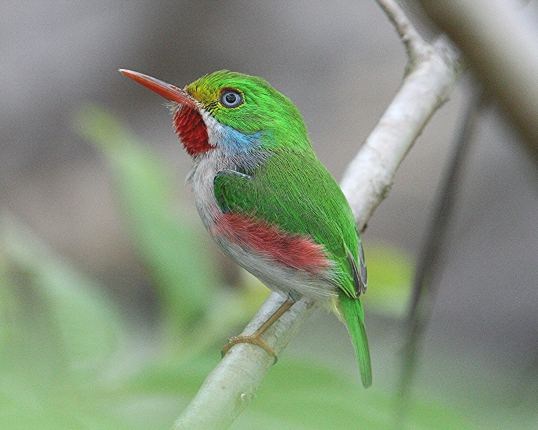
TUESDAY
SEPTEMBER 15 - 2015
Brook
Meadow
I had my now
daily stroll through Brook Meadow this afternoon. The
meadow is still remarkably dry underfoot despite the
recent rain. I met Patrick Murphy and his wife (sorry
I don't know her name) on the north bridge. They had
been down to the Millpond mainly to watch the
spitfires flying over. Here is a cracking shot he got
of two flying over.
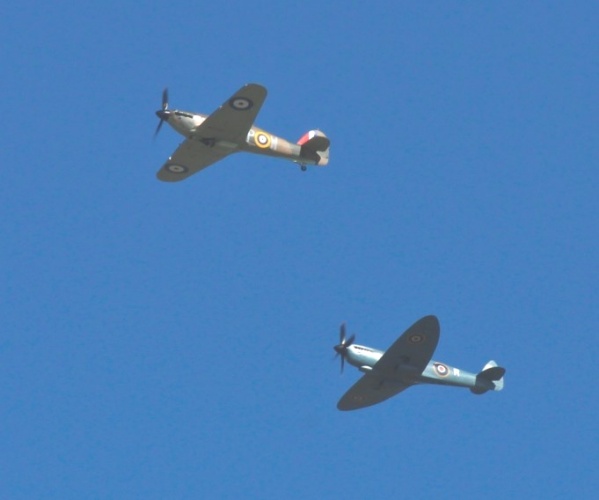
Correction.
Chris Oakley tells me the top one is a Hawker
Hurricane; rounded wing tips and three
props.
I also met Jennifer
Rye who was carrying out the regular butterfly
transect on the meadow, but had not seen much apart
from a Comma with its wings closed up. Jennifer told
me two interesting pieces of news.
Wasp
nest
Firstly, she
noticed there were a lot of wasps flying around on the
east side of the north meadow near Beryl's seat which
she thought meant there was a wasp nest close by. I
went over to check for myself and also found a lot of
wasps in the air, they appeared to be coming from the
dense plantation of Osiers. I recall Ralph Hollins
mentioning many insects in the air at this spot when
he visited the meadow on Sept 8th. Jennifer says she
will probably be putting up a notice warning visitors
of the presence of a wasp's nest.
Alder
tree infestation
Jennifer also
mentioned that the leaves of the newly planted Alder
tree on the east side of the Lumley area near the
Lumley Stream were badly nibbled. I checked the tree
and found many of the small twigs of the small sapling
had been totally stripped of their leaves. It did not
take long to discover the cause, numerous small
caterpillars on the leaves - I counted at least 50 of
them. They were pale green with black spots along
their bodies and black faces. From a search on the
internet I think they are the larvae of the Hazel
Sawfly (Croesus septentrionalis),
though clearly they are not restricted to feeding on
Hazel.
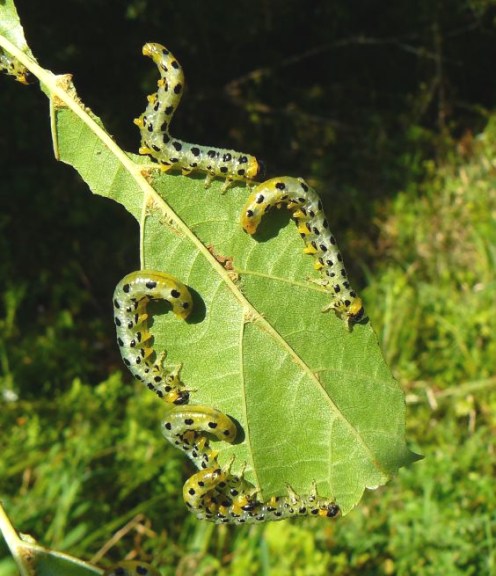
I gather that Sawfly
larvae differ from caterpillars in the number of
prolegs. Caterpillars may have up to five pairs of
abdominal prolegs, but never have more than five
pairs. Sawfly larvae will have six or more pairs of
abdominal prolegs. This can be seen on the photo where
the larvae have 8 prolegs.
A little later, I also met Pam Phillips who planted
the tree on the meadow. Pam told me she had the tree
from Frances Jannaway and kept it in her garden for a
while until ready for planting. She noticed then that
its leaves were being eaten by larvae and used a basic
pesticide to get rid of them. Clearly, some of the
larvae must have survived.
From what I can read the general advice is to get rid
of these larvae if one wants to preserve the health of
the tree they are eating. As Brook Meadow is a nature
reserve, this would be best done by hand.
While examining the
leaves of the Alder I found another caterpillar - only
one of these. It was very colourful with a mixture of
red, black, grey and yellow and very hairy. But, the
most distinctive feature of this caterpillar was a
'hump' on its back close to the head. I managed to
identify it on the internet as the larvae of the
Grey Dagger Moth (Acronicta psi).
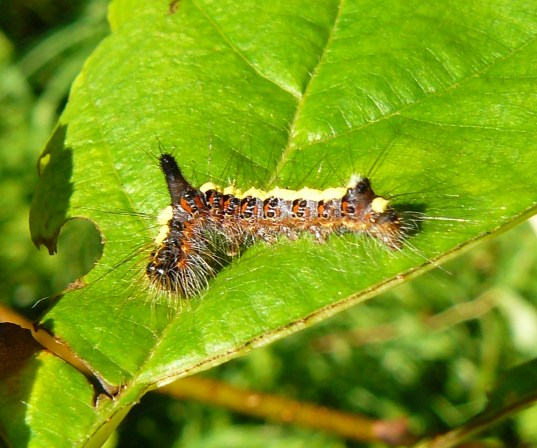
All the 'dagger moths'
get their common English names from the black
dagger-like markings on the forewings of the adult.
The Grey Dagger Moth flies between June and August and
is common throughout England, Wales and Ireland. The
larva feeds on a wide range of plants, mainly trees
and shrubs, including Alder. It overwinters as a
pupa.
Woodpecker
with Collared Dove
Graham Petrie
got a nice shot of a Great Spotted Woodpecker
accompanied by a Collared Dove on his dead apple tree.
This is the first time I believe I have seen this
particular combination of birds together.
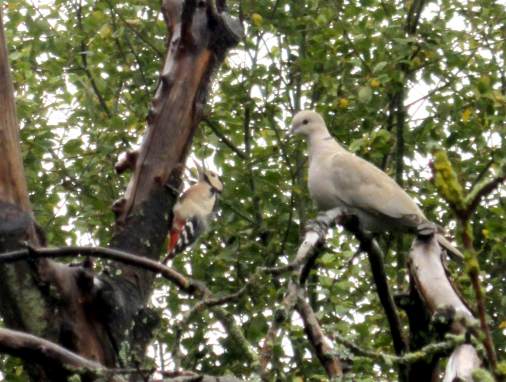
MONDAY
SEPTEMBER 14 - 2015
Brook
Meadow
I had a walk
through Brook Meadow this morning after the rain. I
was surprised how dry the ground was despite last
night's heavy rain. I walked down the main river path
from where I saw an adult Moorhen resting on a
pile of reeds left from last week's river clearance. I
also spotted a fairly mature juvenile Moorhen, so
let's hope the breeding went well this year.
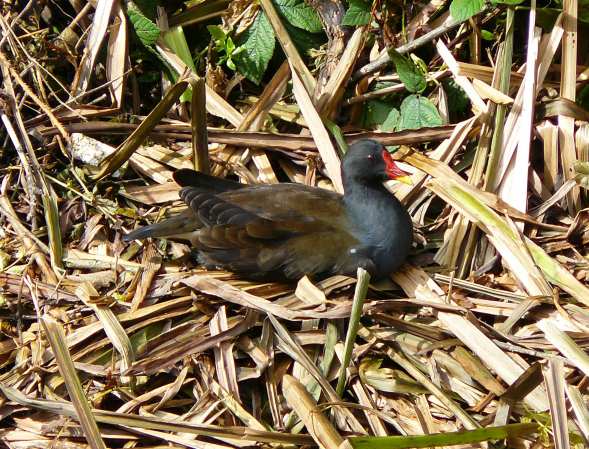
It is good to be able
to get a view of the river following last week's
clearance by the Environment Agency. The river is
running well after the rain and is grey with suspended
sediment.
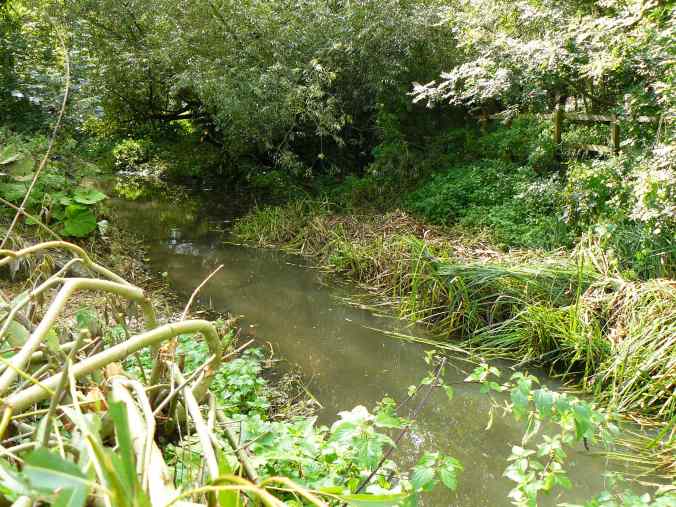
I met Ruth Roberts who
told me she had seen a Slow-worm crawling
across the footpath near the north bridge. This maybe
one of those relocated by the ecologists from a local
building development site.
I noticed a few hoverflies on the flower heads
of Hogweed and Wild Angelica, including these two
chaps, Syrphus ribesii and
Episyrphus balteatus - aka Marmalade
Fly.
The Ash saplings
on the causeway are now decorated with hanging
seed 'keys'.

Close by the red haws
are shining very brightly on the Hawthorn bush.
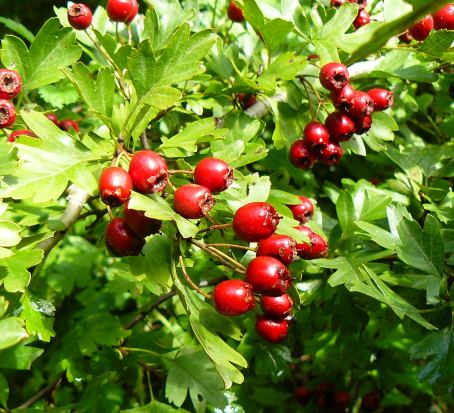
However, there do not
seem to be many berries on the Alder Buckthorn
bushes this year. The large Horse Chestnut tree
has a severe infestation of leaf miner grubs, but this
does not appear to have affected the conker fruits of
which there is a very good crop. What a pity kids do
not play conkers these days.
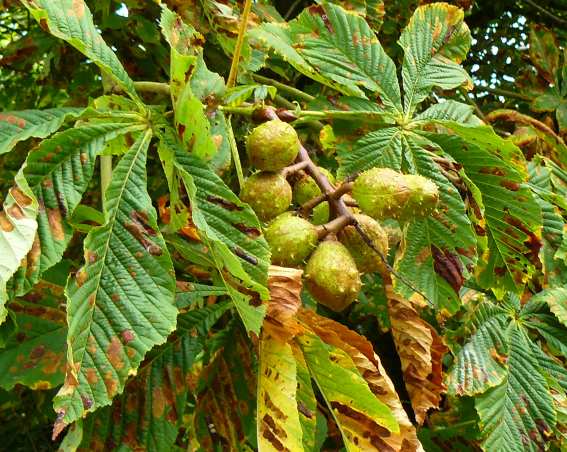
Wild Angelica
continues to dominate the south meadow with its
predominantly white flower heads, but some of them are
deep purple like the stems.
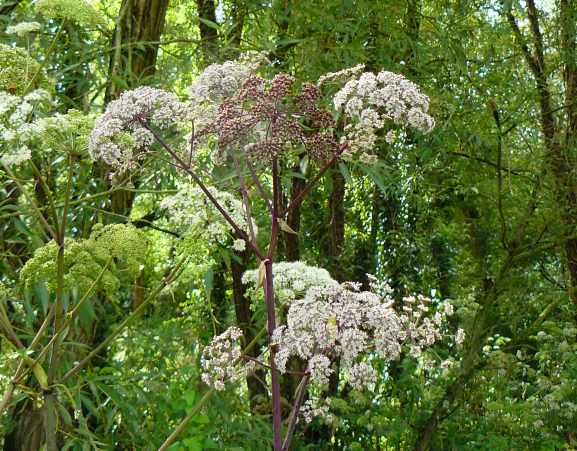
The twisted seed heads
of Great Willowherb with their long silky hairs
adorn several parts of the meadow.
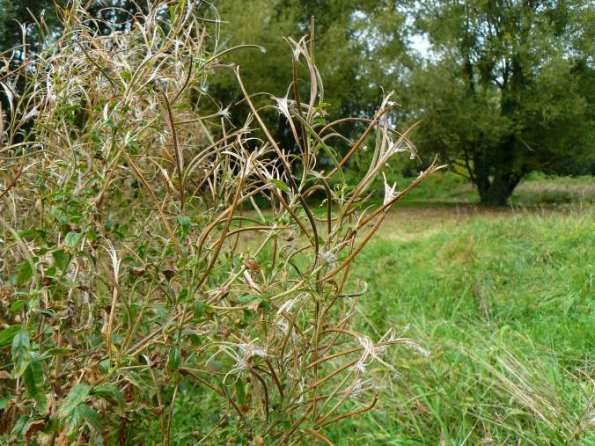
Meanwhile, the brown
seed heads of Common Fleabane are now gradually
replacing the bright yellow flowers.
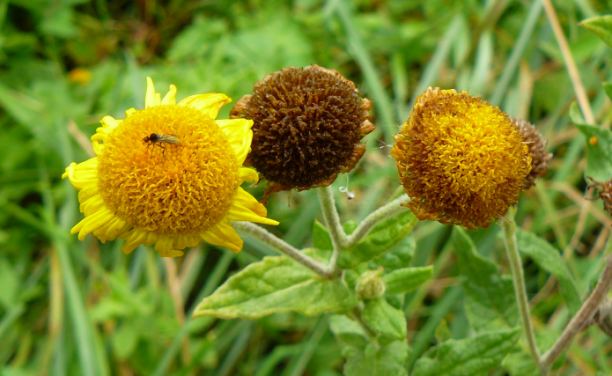
Another team from the
Environment Agency has been busy reinforcing the bund
separating Brook Meadow from the garden of Gooseberry
Cottage. A line of stones in wire bags ('sausages')
have been placed at the base of the bund; these hold a
waterproof membrane. The basic idea is to enhance the
water resistance of the bank that protects Gooseberry
Cottage.
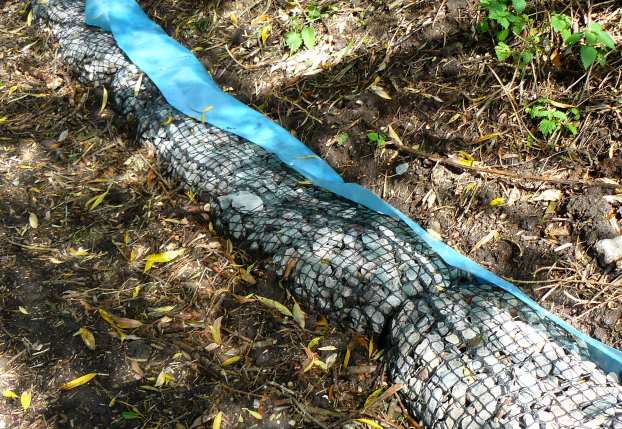
Southern
Hawker
Graham Petrie
managed to snap this female Southern Hawker
depositing eggs all around his garden pond area. He
thought she was stretching her body down between the
wooden pond cover to drop eggs onto the waters
surface.
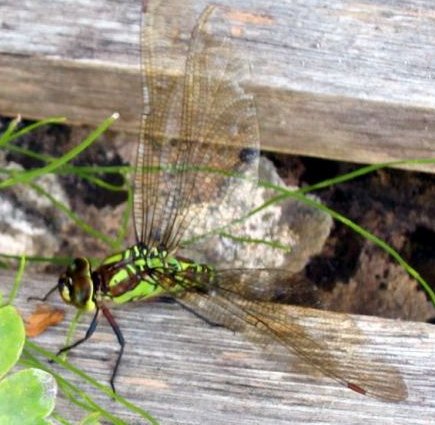
Langstone
Mill Pond
Yesterday,
Peter Milinets-Raby went out for a walk with his young
son Aleksandr from 10:20am to visit the Langstone Mill
Pond.
"We walked in via Wade Lane. The highlights were as
follows: Siskin heard going over, 2 Swallows over,
male Blackcap.
Langstone Mill Pond: 26+ Little Egrets roosting in
trees seeing out the high tide, Cetti's Warbler,
Chiffchaff, Yellow Wagtail and Siskin all heard.
Off shore: 15 Teal, 16+ Swallow moving, 15 Bar-tailed
Godwit heading west down the middle of the
channel.
And in the stream outflow were, just three cygnets
with the two adult Mute Swans. I searched high and low
for the other three cygnets". Brian's note: maybe they
have learned to fly and have gone off - or been driven
off.
SATURDAY
SEPTEMBER 12 - 2015
Malcolm's
news
Malcolm
Phillips did his regular round of Brook Meadow with
his camera this morning and got some nice pics. Here
are a few I have selected, Long-tailed Tit with bright
eye, Comma surrounded by luscious Blackberries and
male and female Common Darters - by far the most
common dragonfly on Brook Meadow at the moment.
Environment
Agency work
Maurice Lillie
reports on the progress of the Environment Agency in
reinforcing the bund on along the west side of the
east bank in South Meadow as part of the flood defence
project for this area. "A small earth scraper is
making a shallow trench along the foot of the bank and
steel mesh stone filled 'sausages' are being laid in
the trench to the bank. These are holding a waterproof
membrane in place to enhance the water resistance of
the bank that protects Gooseberry Cottage. A second
row of the same product will be laid on top of these,
hopefully next weekend. The dimensions and flexibility
of the 'sausages' allow a natural profile to be
followed. I understand that the EA do not intend to
extend this protection as far as the concrete outlet
in the south east corner, as first
thought."
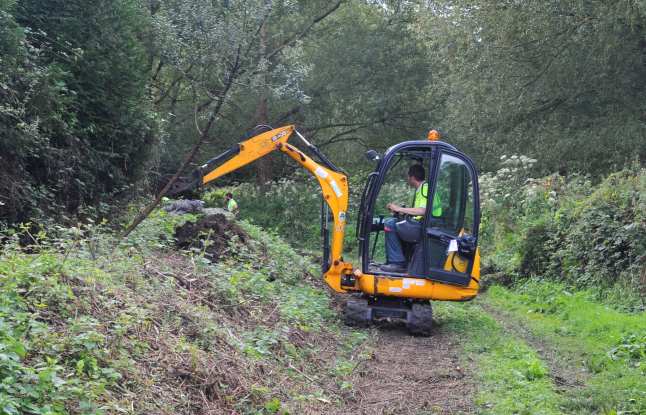
For more photos go to
. . . http://www.brook-meadow.hampshire.org.uk/bm-diary-2015b.html
Brent
Geese arrive
Yesterday
(Sept 11th), Ralph Hollins saw the first flock of
Brent Geese of the 'winter' in the on the Hayling side
of Langstone Harbour - he estimated 75-100. There have
been a few non-migrating Brents in the harbour over
the summer, but the ones that Ralph saw will be the
first true migrants from the Arctic breeding grounds.
Ralph noted the geese were reaching down into the
water, obviously hungry to get a meal of their
favoured Eelgrass (Zostera marina) after
their long journey. We rare see Brent Geese in
Emsworth until well into October, probably indicating
the scarcity of Eelgrass in the harbour.
Here is a photo I got
of the first Brent Geese a few years ago near Eastney
in Langstone Harbour.
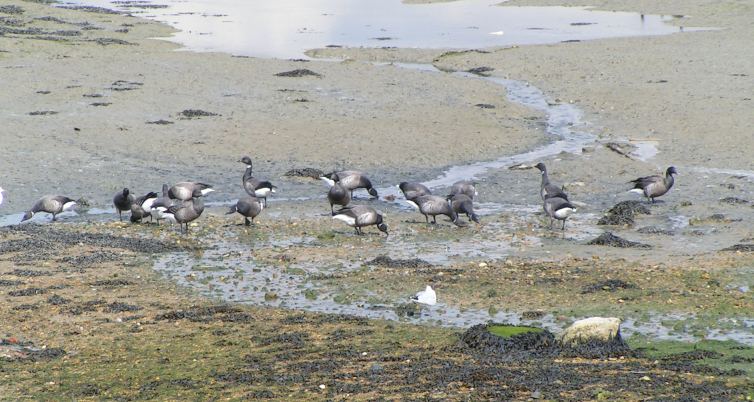
FRIDAY
SEPTEMBER 11 - 2015
Malcolm's
news
Yesterday he
had virtually nothing on Brook Meadow, but today
Malcolm Phillips had plenty of birds including female
Blackcap with raised crest, male Chaffinch, Great Tit
and a Goldcrest which we have not seen for a while.
Malcolm also saw a Fox
at the river edge by the old gasholder, but it was too
quick for a photo. He also got a picture of what might
be the only remaining Pike in the river.

THURSDAY
SEPTEMBER 10 - 2015
Brook
Meadow
I had a short
walk through Brook Meadow this morning. It was warm
and sunny, but I saw very few butterflies apart from
whites fluttering around. The best insects were
certainly the dragonflies of which Common
Darters were numerous. Here is a female I snapped
when she came to rest.

I also had a
Southern Hawker flying around my head; this is
a curious dragonfly which often flies close to examine
you.
I noticed a very hairy fly feeding on Pepper-saxifrage
on the Lumley area. It had a red-orange abdomen and
was quite active, flying quickly from one flower head
to another. My guess is that it was a species of
House Fly - possibly Graphomya
maculata though that is no more than a wild
guess by comparing my image with the illustration in
Chinery (p. 215).

I could not resist
snapping this beautiful Four-spot Spider
(Araneus quadratus) which was sitting in
its web waiting for some unsuspecting prey to arrive.
The Four-spot Spider's web is not nearly as neat and
well constructed as the web of the Garden Spider
(Araneus diadematus), but no doubt just as effective
in trapping prey.

I met John the
ex-postman and his wife walking down the main path
next to the river with their black dog. They had just
spotted a pair of mating Common Darters flying
around together. I managed to find them when they came
to rest and got this nice photo. The male is red.
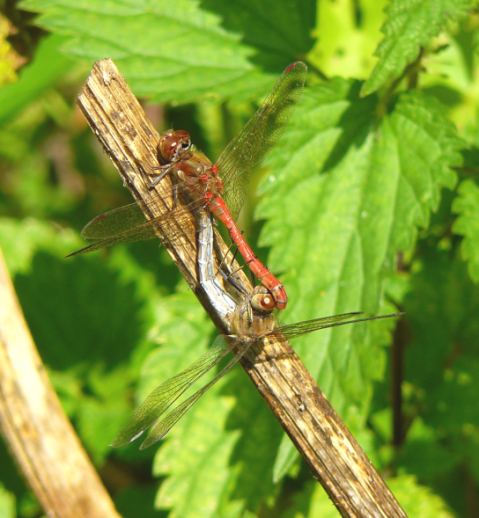
John bemoaned the
absence of birds in his garden despite putting food
out. I reassured him that it was normal for birds to
hide away at this time of the year as they change
their feathers after nesting. It also probably meant
there was plenty of natural food in the wider
countryside. But, they will be back, so keep putting
the food out.
Buzzard
on Hampshire Farm
Brian Lawrence
had a walk around Hampshire Farm this afternoon and
saw a Buzzard hunting and got a good shot of it in
flight. From Brian's photo this looks like a juvenile.
It lacks the distinct tail band of an adult and its
underparts are coarsely streaked.

Warblington
shore
Peter
Milinets-Raby was again down the Warblington shore
this morning (6:32am to 8:41am - tide slowly pushing
in).
Ibis Field: 7 Pheasant, 1 Whitethroat (so few migrants
this autumn, but there again over the last few years
the area never gets many), 5 Great Tit.
Conigar Point: 2 Yellow Wagtails over and one in the
long grass in with the cattle for a few minutes before
moving on, 1 Great Black-backed Gull, 47 Ringed
Plover, 3 Grey Plover, 64 Dunlin, 2 Greenshank, 2
Lapwing, an undetermined flock of Siskin heard going
over, 3 Chiffchaff in Tamarisk Hedge.
Off Pook Lane: 9 Greenshank (G//R+LN//- &
RG//+YY//- & G//R+GO//- & G//R+YN//- &
R//G+YY//-), 3 Black-tailed Godwit, 4 winter Med Gulls
on the mud with 120+ Black-headed Gulls before moving
off inland, 4 Dunlin, 16 Teal, 2 winter plumaged
Sandwich Tern resting on the mud, 6 Swallow over, 60+
Redshank (-//B+B//NG & -//B+B//GN).
Langstone Mill Pond: 1 Grey Wagtail over, 1 Reed
Warbler, 1 Cetti's Warbler heard, 1 Teal, 1
Chiffchaff.
WEDNESDAY
SEPTEMBER 9 - 2015
Brook
Meadow
I had a walk
through the meadow this morning mainly to have a look
at the river clearance. The Environment Agency did a
good job, but the river banks are still a jungle of
brambles and nettles which largely hide the river To
improve the visibility of the river the banks really
need an annual clearance like the river itself. Maybe
the conservation group can organise someone to come
and do it? Or even do it themselves?
I noticed a single
young Moorhen making its way gingerly through the
tangle of cut twigs that litter the banks of the
river. Less welcome was a black cat sitting on a log
overlooking the river.
Slipper
Millpond
I walked round
the pond which was very quiet. The only birds on the
large centre raft were a collection of Black-headed
Gulls and a single Cormorant. However, there is a fine
growth of what looks like Scentless Mayweed. There was
no sign, of course, of any Great Black-backed Gulls
which left empty handed some weeks ago.
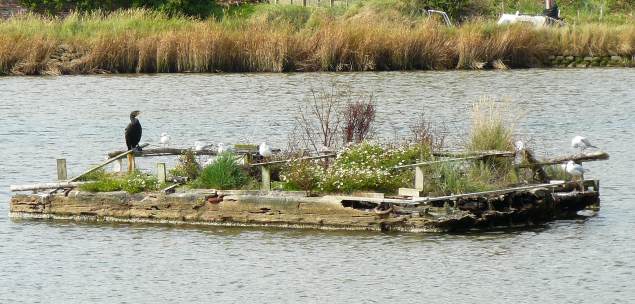
I see from the current
Newsletter of the Slipper Millpond Preservation
Society that the nesting gulls issue will be discussed
at the AGM (on Oct 23 at 8pm at Hewitt's, South
Street), ie, whether to renew the protective wiring on
the rafts to discourage nesting. In fact, the wiring
has not worked as the gulls have nested successfully
since it was erected two years ago, though they did
lose their two youngsters this year due to drowning.
On the east side of
the pond I noted Common Knapweed in flower,
unusually with fully rayed flower heads, Prickly
Lettuce with tiny yellow flowers.
Also, on the east side
of Slipper Millpond I found a bush of Rosa
Rugosa (or Japanese Rose) with large bright
red hips.
The Shaggy Soldier is in flower on the roadside
kerb at the bottom of Queen Street as mentioned by
Ralph Hollins in yesterday's report. This is a regular
place for this relatively uncommon plant.
Finally, I had a look
at the large Horse Chestnut tree in that
overhangs the footpath that leads down from King
Street to Dolphin Lake and noted that it had very few
conkers. Is this a poor year generally for them, I
wonder?

Chichester
Peregrine at Hayling
Tom Bickerton
confirmed that the photo of the juvenile female
Peregrine in yesterday's blog report was almost
certainly a bird from this year's brood on Chichester
Cathedral. I was not sure since I could not see the
ring on the leg in the photo, but Tom said it was
black and not easy to see. He sent another pic of the
bird taken by his colleague Marianne which shows the
ring on its left leg more clearly.
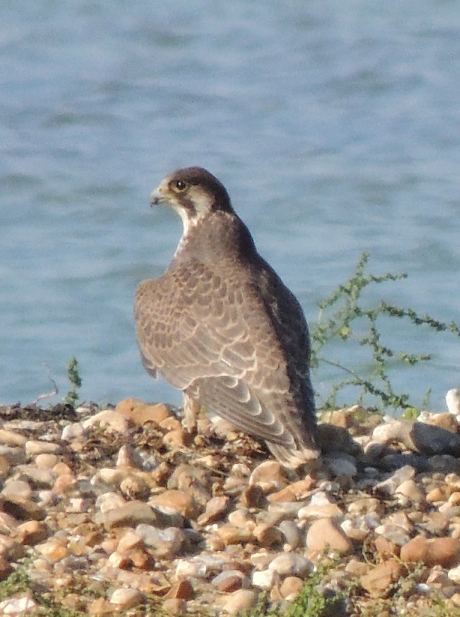
Tom was pleased to see
this Chichester Peregrine at Hayling Oysterbeds as it
confirms his linkage theory between the two sites,
though I gather Pete Potts is less pleased as it is a
big disturbance to roosting waders at the Oysterbeds.
Mystery
bird corpse
During his
visit to Emsworth yesterday Ralph Hollins had an
unusual observation as he rode his bike uphill from
the Peter Pond area to the town centre roundabout. "In
the centre of the road was a totally unidentifiable
splodge where some bird had been run over maybe
hundreds of times, but somehow a single leg had
survived to give a clue - the leg seemed to be coated
with pure white feathers right down to what seemed to
be a foot with claws - could this have been a Little
Owl???"
Warblington
shore
Peter
Milinets-Raby was out this morning for a walk along
the Warblington shore (6:20am to 8:40am - tide slowly
pushing in).
Conigar Point: 1 Spotted Redshank, 1 Knot, 6
Greenshank (G//R+BY//- & N//R+RY//-), 17 Grey
Plover, 13 Dunlin, 2 Ringed Plover, 13 Bar-tailed
Godwit, 1 Stint species seen for just 10 seconds: Very
likely to be a Little - not in juvenile plumage,
Chiffchaff Heard, Yellow Wagtail over.
Off Pook Lane: 31 Bar-tailed Godwit, 9 Dunlin, 7
Greenshank (B//R+GR///- & RG//-+YY//- &
G//R+YN//- & G//R+LN//- & NR//- +YY//-), 11
Grey Plover, Yellow Wagtail over, 4 Adult winter Med
Gulls over inland, 14 Teal, 2 Sandwich Tern, 2
Black-tailed Godwit, 60+ Redshank (-//B+B//NO &
-//B+B//NG & -//B+B//RR & -//B+B//GN).
Pond: Cetti's Warbler singing a few times, Chiffchaff
seen, Kingfisher dashing across, 3 Teal, 2 Adult
winter Med Gulls over inland.
TUESDAY
SEPTEMBER 8 - 2015
River
clearance
I went over to
Brook Meadow this morning to check on the progress of
the river clearance by the Environment Agency. Mark
and his team were working their way down river,
clearing overhanging branches, brambles, etc and
clearing a channel through the river vegetation. I
encouraged Mark to clear as much of the in channel
stuff as possible, but they are doing a good job. Here
are a few shots of the team at work.
Malcolm's
news
While all this
noise and activity was happening in the river, Malcolm
Phillips was quietly taking photos of the wildlife on
Brook Meadow. I have included a couple of his pics
from today.
Ralph's
news
Ralph Hollins
was in Emsworth today and noted the following:
1. In the uncared for
garden of 581 Southleigh Road (almost opposite what
used to be a shop) I saw both Great and Moth Mullein
flowering - later I saw another Moth Mullein flowering
in a Lumley Road garden south of the Brook Meadow
entrance and before Peter Pond comes into open
view.
2. Further up Lumley
Road there were still a couple of flowers on the
Skullcap on the stream wall upstream of the bridge to
4 Raglan Terrace.
3. In Brook Meadow,
coming south from where the Ems enters from Constant
Spring, and just before reaching the Gwynne Johnson
memorial Rowan trees, I parked my bike against a
wooden bench to walk round a clump of Willows in
search of Wasp Spiders which I did not find, but on
the west side if the Willows in warm sunlight. the air
was full of very active insects. My first impression
was that someone had just disturbed a Wasp nest and
the whole colony was flying around aimlessly. When I
got closer I found several other insect species
involved in the same excitement and my second
impression was that something had spread a pheromone
over the leaves of the trees and blackberry bushes,
causing the insects to search every leaf for something
they could not find but which greatly excited them. No
idea what was going on....
4. The Wild Clary was
still flowering at Christopher Way and much further up
New Brighton Road near the roundabout I passed a
single plant of Fox and Cubs (Pilosella aurantica)
just opening its flower head in grass outside house no
11 (East side)
5 Back at the Queen
St/A259 junction the Shaggy Soldier was flourishing.
6. At the Havant
Road/A27 underpass the Field Woundwort was also
flourishing. I've never seen you mention this and in
case you haven't spotted it look in the north side
gutter a couple of metres or so after entering the
narrow section of road heading down into the
underpass. Several plants were flowering today though
the flowers were closed when I passed.
Peregrines
at the Oysterbeds
Tom Bickerton
thought we might be interested in the events he
witnessed on Sunday (Sep 6) at Hayling Oysterbeds,
concerning a juvenile female Peregrine and a flock of
Redshank.
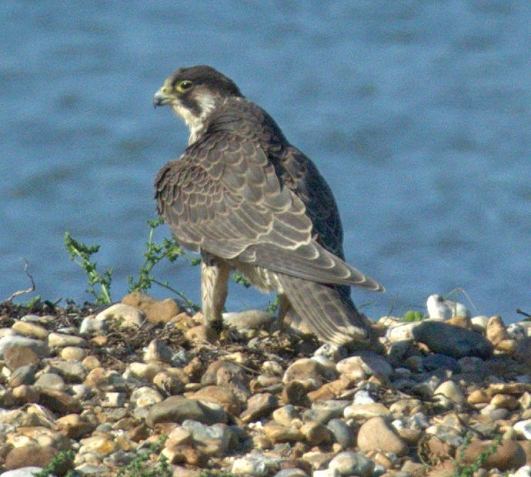
"Nothing strange in a
Peregrine attack, but it's the Redshank's initial
reaction that was odd. About an hour before high tide
60 Redshanks with an assorted mix of Dunlin and Ring
Plovers roosted on the south island of the Oysterbeds.
My attention was alerted suddenly to the warning call
of the Redshanks and about half took to flight and
legged it over Stokes Common. Scanning the sky, I
couldn't see anything, but after about 5 seconds a
female Peregrine came in low and fast over the bush
area towards south island, whereon the roosting birds
took flight. She just missed on the first attempt;
turning rapidly she again missed on the second
attempt. But she managed to separate one Redshank;
both birds then hurtled through the bush area. Anyone
on the Billy Trail would have had the fright of his or
her life. The Redshank must have escaped as the
Peregrine returned again over the lagoon, narrowly
dipping-out on a Black-headed Gull, which had just
woken up to the fact that there's a Peregrine about.
In fact, there were two Peregrines, another bird was
over Stokes Common, so the initial take-off of
Redshank may well have run into trouble.
Now, concerning the Redshank, they must have seen the
Peregrine coming, so some took flight, whether the
others ascertained this was a juvenile and the threat
was less likely than an adult is conjecture, but even
with a juvenile it's a gamble and a risky business to
play.
The juvenile Peregrine has a black ring on her left
leg; Graham Roberts thinks it is one of his two
females ringed from Chichester this May. She is easily
identified from her long moustache and high white
cheek, and she's big, and she will be very dark as she
moults, so if anybody does see her or any others
around the Oysterbeds channel through to Northney then
Graham at . . . graham.c.m.roberts@btinternet.com
. . would be delighted to know.
Peregrines may set-up
a winter hunting ground within this area. Adults do
hunt in tandem, usually to take down larger waders
such as Curlew, or their favourite meal, Duck. I don't
think this was the case here which was just juvenile
enthusiasm. Peregrines are on the increase in the
harbour; unfortunately it's a double-edged sword
concerning these birds, as all the harbours are
designated SPA areas for geese and waders. So all
efforts are directed towards the improvement for these
species. But, it's a good time now to see birds of
prey within the harbour, as well as Peregrines,
Hobbies, a single Merlin and Marsh Harrier, Ospreys,
Kestrel and Sparrowhawk are all about."
MONDAY
SEPTEMBER 7 - 2015
River
clearance
I was very
surprised to get a phone call this morning from Mark
Houghton of the Environment Agency to say that he and
his team were coming over to Brook Meadow this
afternoon to clear the river. I phoned Jennifer Rye
(Chair of the Brook Meadow Conservation Group) and she
knew nothing about it either. I met Mark and his team
of four in Palmer's Road Car Park and together with
Jennifer we walked up the main river path discussing
what to do. It was agreed that Mark should go ahead
and clear a channel in the river and strim some of the
river bank, mostly the eastern side. They would start
this afternoon and continue tomorrow morning until the
whole length of river was done.
Here
is Mark with some of his team arriving over the south
bridge

They started at the
northern end and here you can see one of the chaps
strimming the brambles on the edge of the railway
embankment.
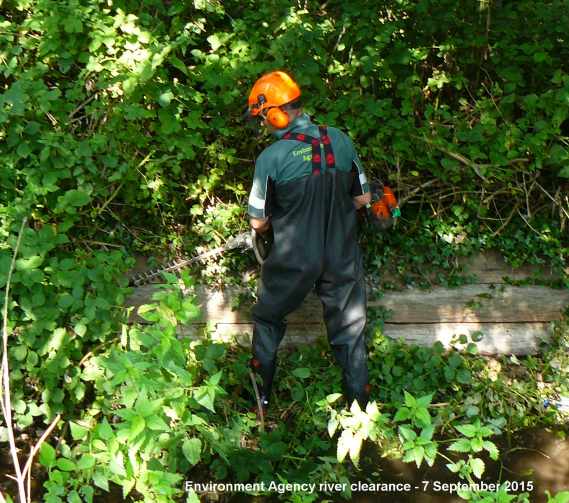
Another two members of
the team cut a channel through the dense growth of
reeds at the north bend. Here is a chap working his
way down river towards the north bridge.
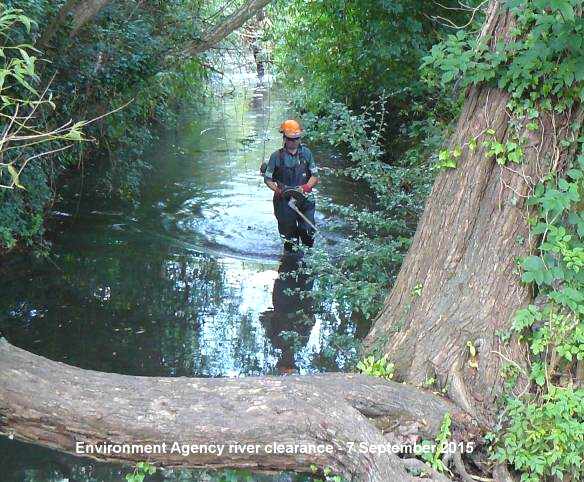
Two of the workers
discovered a Pike among the reeds south of the north
bridge which was allowed to escape before the cutters
moved in. I secretly wished they had chopped it!

Here is a Beautiful
Demoiselle that had been disturbed by the cutters
on the north bend, but unharmed.
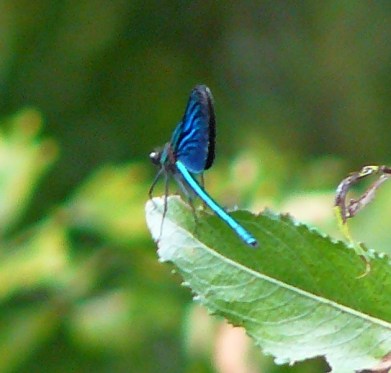
Malcolm's
news
Malcolm
Phillips was out and about on Brook Meadow this
morning and managed to get cracking images of two of
our most common birds, Robin and Goldfinch.
Malcolm's patience
also paid off with this splendid shot of a male
Kingfisher in flight carrying a small fish
through the reedbeds on Peter Pond.
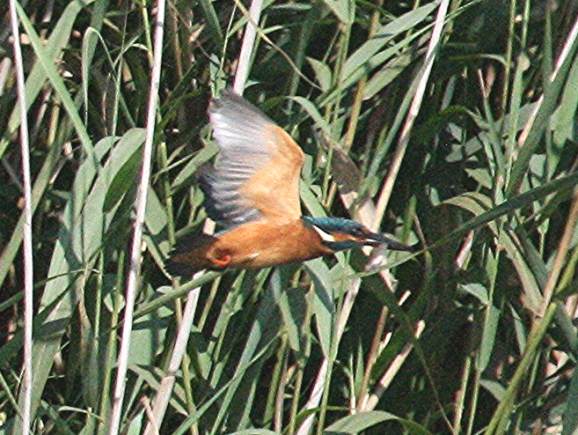
Finally, when he got
home a beautiful Brimstone butterfly was
feeding on the Buddleja.
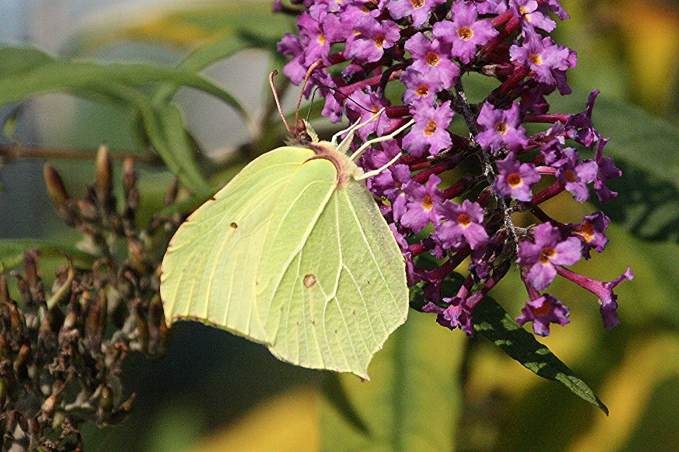
Fungus
montage
Chris Oakley
sent the following interesting montage of fungi taken
on the roadside verge at the southern end of Redlands
Lane where the developers left an island of trees,
mostly oak and ash, with grass on either side. If you
are into fungi, it might be worth going up there to
have a look. If you can identify any of them please
let me know.
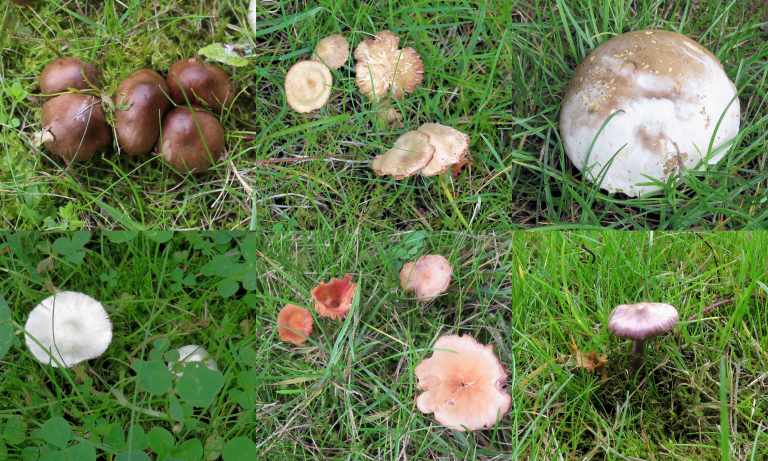
SUNDAY
SEPTEMBER 6 - 2015
Brook
Meadow
I went over to
the meadow this morning for the regular Sunday work
session. The weather was fine and sunny and there was
a good turn out of 13 volunteers. Jennifer Rye was
leader and outlined the main jobs which were 1.
helping Ben Spraggon to clear the experimental area on
the north meadow, 2. cover the new hibernacula with
grass cuttings from the annual cut, 3. cut back the
willow river bank hedge which is sprouting, 4. cut the
south eastern corner of the south meadow where the
flood defence work is happening. I took lots of
photos, though the sun was too bright for quality.
Ben Spraggon arrived with his large Tracmaster power
scythe on a trailer. It is a larger model than ours
with larger engine, wheels and cutting blades. The
group are thinking about getting one thanks to a
generous donation from Frances Jannaway. Ben
demonstrated the machine by cutting a large section of
the north meadow for the new experimental seeding
area. The idea is to try to discourage course grasses
by planting Yellow Rattle.
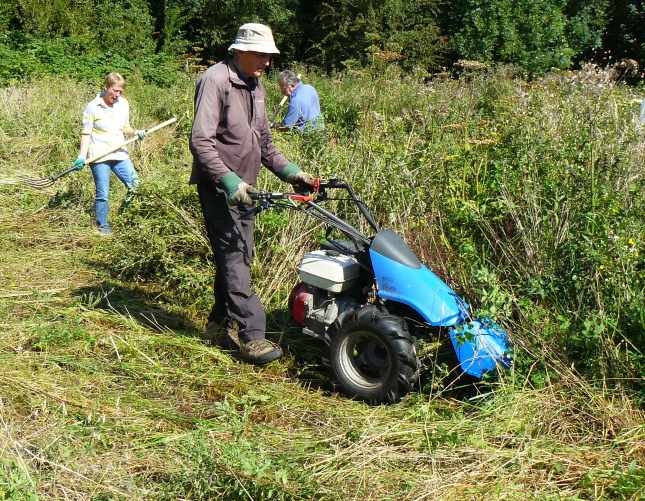
For a full report on
the work session together with more photos go to . . .
http://www.brook-meadow.hampshire.org.uk/bm-diary-2015b.html
Brown
Trout
Malcolm
Phillips did not have much to report today but he spot
the following Brown Trout which was a different colour
from usual in the channel north of Peter Pond.
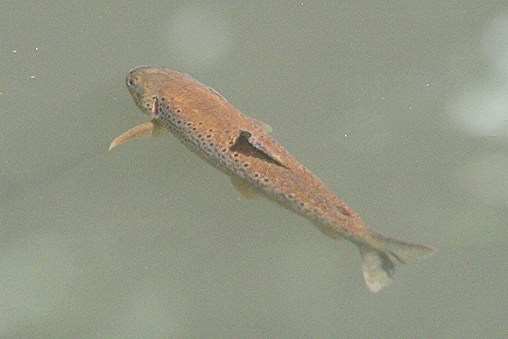
I gather Brown Trout
vary a lot in colour, depending on their habitat from
silver through shades of brown with reddish orange
spots on their flanks. I think this one is within the
normal colour range for Trout.
Hummingbird
Hawkmoth
Brian Lawrence
has been having a Hummingbird Hawkmoth come into his
garden on the Buddleja for about a week. But today was
the first time he was able to get a photo. These large
moths which hover in front of flowers are often
mistaken for Hummingbirds, though we never see these
North American birds in this country outside of
aviaries.
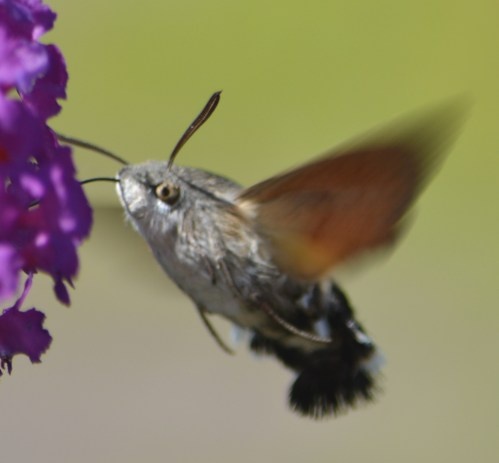
SATURDAY
SEPTEMBER 5 - 2015
Hornets
Hornets are
magnificent creatures when one manages to get a good
look at them. The only one I have seen this year just
flew past me on Brook Meadow. But this is a good time
to see one as the nests start to break up. As in other
wasps all the work is done by the females which catch
other insects to feed the young in colonies. Males
appear in late summer, most often seen on flowers.
They tend not to be bothersome like common wasps.
Romney and Ken Turner have been on a special project
looking for and photographing Hornets in their local
area, but they are difficult to photograph unless they
stop to clean or catch something. Romney and Ken
managed to get some excellent photos of a Hornet
stealing a fly that had just been caught in a spider's
web and flying off with its prize. The spider was
sensible not to offer any resistance to the theft.
Romney and Ken also saw a Hornet catching its own prey
which they said was 'a bit gory, but fascinating to
watch how the wasp hangs from two legs and manipulates
and dismantles its prey before flying to the nest with
it'.
On
the left is the Hornet in the act of stealing the fly
from the web. On the right is the Hornet making off
with its prey
FRIDAY
SEPTEMBER 4 - 2015
Emsworth
Harbour
I went down to
the harbour this morning to see what I could find in
the way of waders. The tide was rising to high water
in about 4 hours. From the marina seawall I could see
plenty of Black-tailed Godwits in the harbour,
some feeding, some snoozing. I counted 33 of them,
though I strongly suspect there were many more behind
the boats. They included two colour-ringed birds:
G+WR - This
bird was ringed at Farlington Marshes on 10-Sept-08 as
adult male. It has been one of our most regular winter
visitors over the years and this was the 117th
sighting!
LY+RO - This
bird was ringed on territory in Iceland on 11-Jun-03
as breeding male which makes it at least 12 years old.
It has been a fairly regular visitor to Emsworth
Harbour each year since then and this was our 16th
sighting. It has also been seen Pagham, Fareham,
Farlington, Avon Valley, Ireland, France and Portugal
so it gets around.
Here
is a photo taken from a previous visit by LY+RO in
2010.
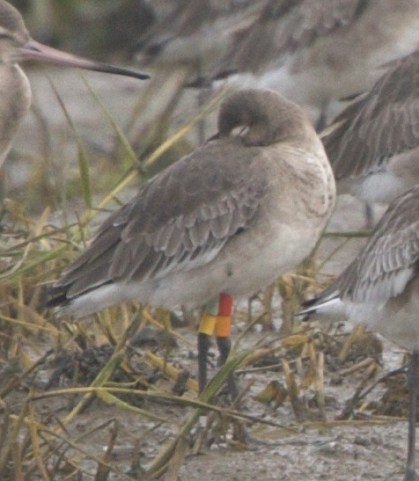
Other birds: 70+
Redshank, 22 Turnstone, 4 Greenshank, 3 Curlew, 6
Oystercatcher, 1 Grey Plover and a Lesser Black-backed
Gull - see digiscoped photo.

Brook
Meadow
Although the
meadow appears to be very quiet on the bird front at
the moment, with little in the way of song,
nevertheless the birds are still here as a very
patient Malcolm Phillips proved today by snapping some
of the most likely candidates. In addition to a couple
of our residents Blue Tit and Long-tailed Tit, Malcolm
also got two of our regular summer visitors female
Blackcap and Chiffchaff.
Mystery
bug
Eric Eddles
came up with an answer to the mystery bug that Malcolm
Phillips had on his arm yesterday. Eric thought it was
a larval state of a Tritomegas species of
burrowing bugs (Cydnidae).
Here
is Malcolm's bug
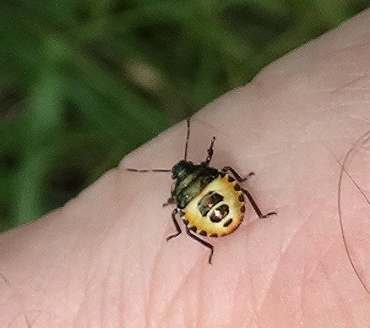
Following a search on
the internet, I managed to locate what I think might
be the actual species on the British Bug web site
which is an excellent source of information. I think
it could be (fingers crossed) a nymph Woundwort
Shieldbug (Eysarcoris venustissimus) -
although there are many similar varieties.
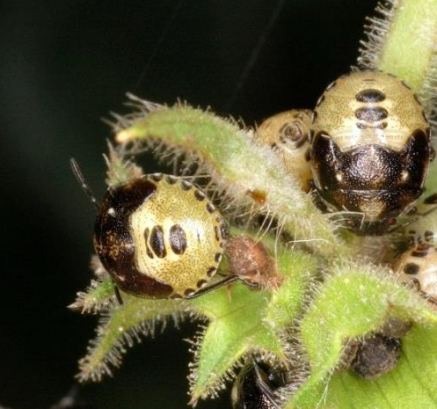
This shieldbug was
rare in the 19th century, but is now widespread in
southern Britain, north to the Midlands. The nymphs
feed on Hedge Woundwort and sometimes other plants in
the Labiateae such as White Dead-nettle which are
abundant on Brook Meadow.
For more details go to . . . http://www.britishbugs.org.uk/heteroptera/Pentatomidae/eysarcoris_venustissimus.html
There is a link on this site to a very useful chart
showing the stages of growth of various shieldbugs,
including this one.
Warblington
shore
Peter
Milinets-Raby was up early and out to have a walk
along the Warblington shore - 6:22am to 8:38am - tide
falling. Very few migrants around.
Cemetery: Yellow Wagtail over, 2 Swallows,
Chiffchaff.
Conigar Point: 9 Grey Plover, 33 Ringed Plover, 36
Dunlin, 3 Greenshank (two with rings - N//R+RY//-
& R//G+YY//-), 6 Common Tern, 3 Black-tailed
Godwits, 12+ Redshank (three with rings - -//B+B//GG
& -//B+B//ON & -//B+B//GN), 1 lonesome Teal, 8
Shelduck, 4 Bar-tailed Godwit, 1 Lesser Black-backed
Gull, 1 Third calendar year Yellow-legged Gull -
didn't stay long and flew off east.
Off Pook Lane: 1 Greenshank, 40 Bar-tailed Godwit, 1
Knot, 1 Turnstone, 14 Common Tern (2 adults, the rest
juvs), 1 Kestrel, 5 Ringed Plover, 3 Dunlin, 8 Grey
Plover, 1 Turtle Dove flew off the beach and headed
inland, 2 Yellow Wagtails over west, 1 Meadow Pipit
north, 4 Cormorants heading west, 2 Lesser
Black-backed Gulls.
THURSDAY
SEPTEMBER 3 - 2015
Brook
Meadow
Martin Cull
was back on the meadow again with his bright red
tractor to complete the annual cut which he started
yesterday. He finished the centre meadow yesterday and
today moved onto the larger north meadow.
As yesterday, I noticed a number of frogs jumping
around in the cut grass, clearly unharmed by the
tractors blades. I also spotted one Common Toad
which was typically crawling to get into cover.
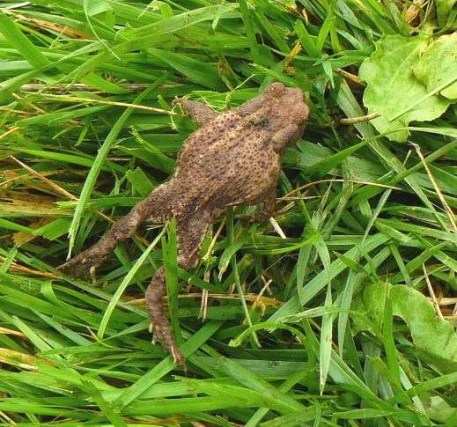
The Pepper-saxifrage
is now in flower on the east side of the Lumley area
and its freshly open flowers were attracting a good
number of mainly hoverflies, including what I think is
Syrphus ribesii.
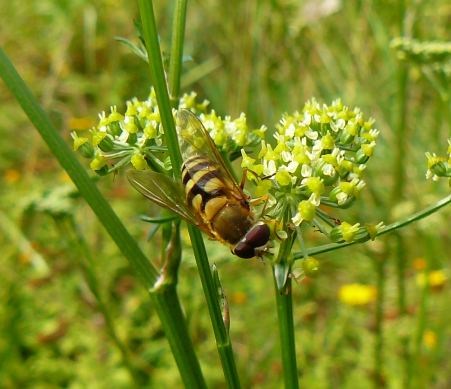
What I think is
Common Orache is growing at the southern end of
the old Bramble path (I can hardly call it that now)
close to the signcase. I am inclined towards Common
Orache rather than Spear-leaved Orache on account of
its diamond-shaped lower leaves, the base of which
taper gradually into the stalk. In Spear-leaved Orache
I would expect the lower leaves to be more
triangular-shaped and make a right angle at the base.
Also, in Common Orache the lower lobes of the leaves
are forward pointing, whereas in Spear-leaved Orache
they point sideways. However, I am never 100% certain
about these plants and I might well be wrong. Common
Orache is not a common plant on Brook Meadow. I
usually find it in this wet area of the south eastern
corner of the south meadow, but some years I never
find it.
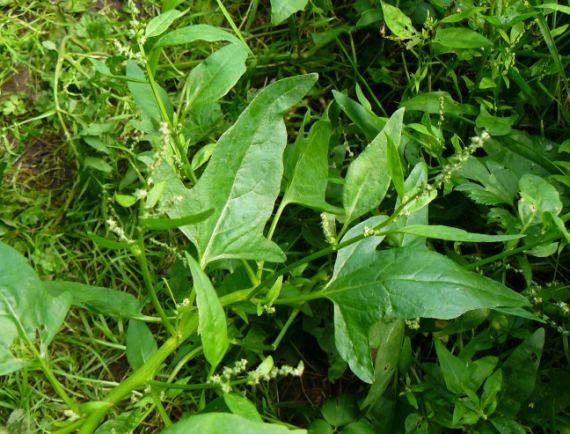
Malcolm Phillips spent
some time on Brook Meadow this morning and got a some
excellent images of very bright butterflies - Red
Admiral and Comma.
Malcolm also had this
tiny yellow and black bug which landed on his arm. It
is not one I am familiar with. Can anyone help?

Fungi
As Chris
Oakley pointed out, this is the season for fungi and
he has found a few in his locality. Here is a
particularly 'lovely clump of Blushers',
presumably on Hampshire Farm, though Chris did not
say. And, just in case anyone might be foolish enough
to try eating them (which the books do not advise), I
gather the white gills and flesh bruise pinky-red
which helps to distinguish it from the highly
poisonous Death Cap.
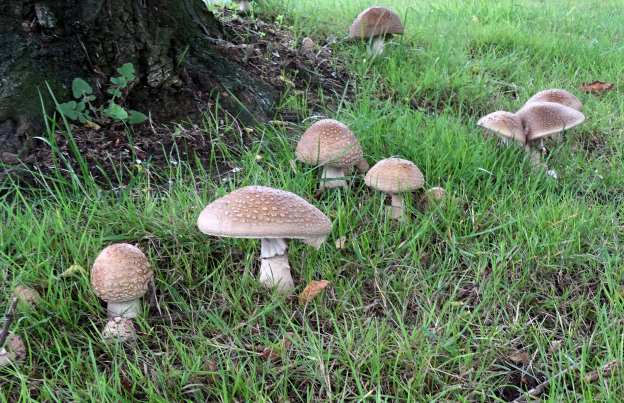
Langstone
Mill Pond
Peter
Milinets-Raby had an hour spare this morning, so he
popped along to the Langstone Mill Pond (10:04am to
10:57am - low tide). The highlights were as
follows:
Langstone Mill Pond: 2 male and a single female
Gadwall all in eclipse. This photo shows a
male.
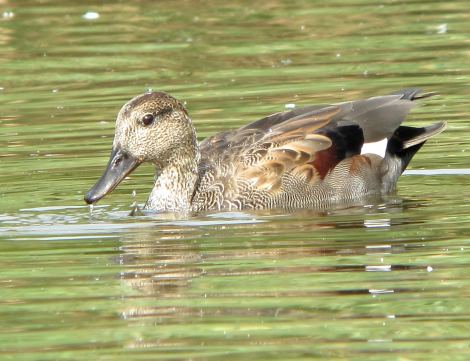
, Adult Reed Warbler
feeding noisy fledgling. 53 Little Egrets loitering in
the trees (plus 3 Grey Herons). Mallard female with
one tiny duckling left "I will survive" (See photo -
However, it almost didn't survive, as it was too busy
watching me taking photos of it, that it almost missed
the approach of the pen Mute Swan - luckily it slipped
away into the reeds. How long can it survive!). 1 Sand
Martin over. 16 House Martins over. 22 Goldfinch
Off Pook Lane: 126 Redshank (one with colour rings
-//B+B//OR), 6 Greenshank (one with rings
G//R+BRtag//- : this bird looking dark and still
sporting some summer plumage, as well as a whopping
big geolocator - see photo).
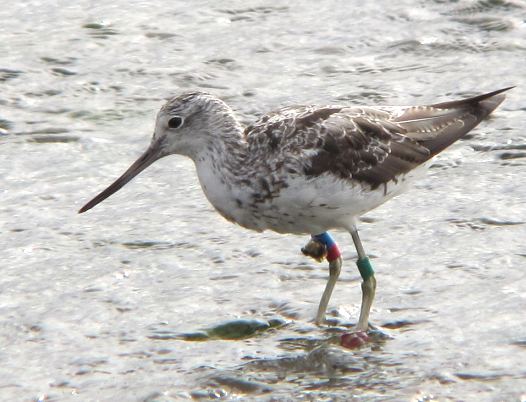
12 Dunlin, 7 Knot (all
in winter plumage), 13 Bar-tailed Godwits, 3 Common
Gulls, 1 winter plumaged Sandwich Tern.
Finally, Peter says we
all need to look out for an invasion of Cattle Egrets
as this area has a history of them.
WEDNESDAY
SEPTEMBER 2 - 2015
Brook
Meadow - Annual cut
I went over to
the meadow this morning with my grand daughters, Lily
and Iris, to see the start of the annual cutting of
Brook Meadow by Martin Cull. This is the main event in
the conservation management programme for the year.
Martin and his father Brian before him, have been
cutting the meadow since the group first took over the
management of Brook Meadow in Year 2000 and they have
always done a good job.
The girls were quite excited to see Martin bring his
shining red tractor onto the meadow and even more so
to have their photo taken with him in front of his
magnificent machine!
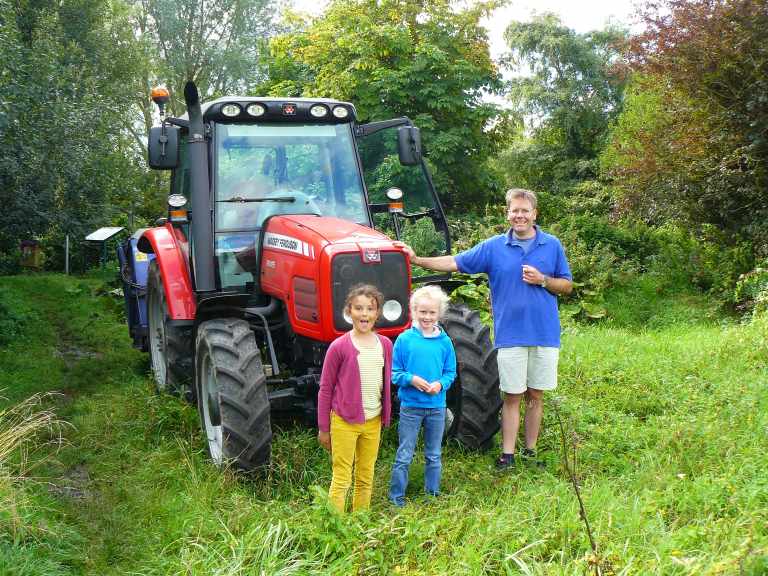
Maurice Lillie was
also present to open the Lumley gate for Martin and
generally guide him around the site. I took the girls
off to the Moka cafe to have hot chocolates and cakes
and when we returned Martin had already done quite a
bit of cutting of the centre meadow. We were
interested to see several Frogs and Toads in the cut
grass, which fortunately the tractor's blades had left
unscathed.
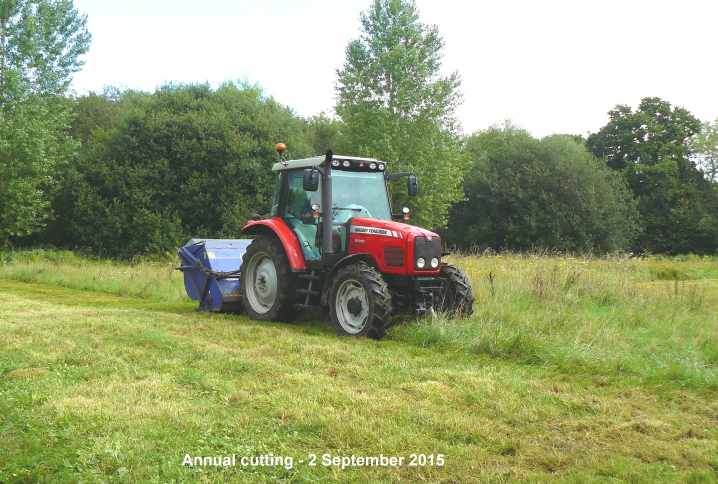
Bird's
Nest Fungi
John Goodspeed
noticed some unusual objects in the grass during his
stint at the BTO Garden BirdWatch stall at the
Emsworth Show on Bank Holiday Monday and wondered what
they were.
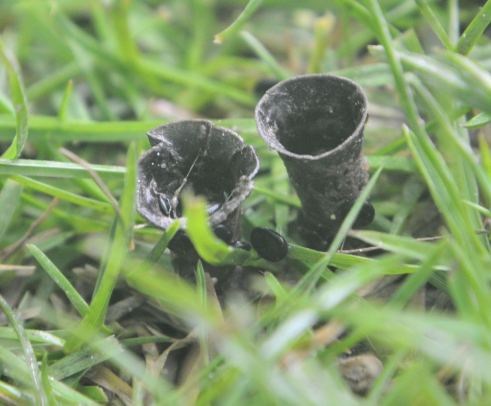
Ralph Hollins had the
answer - they are Bird's Nest Fungi
(Cyathus olla). Ralph went on to relate
this extraordinary story about the life history of
this seemingly insignificant little fungus.
"This fungus has its own labour saving method of
dispersing its spores. "Rather than building a
toadstool-like structure tall enough for the wind to
catch the spores before they hit the ground as they
fall from the gills of a 'mushroom' (or building guns
to shoot out the spores as in the Ascomytes), these
use brain rather than brawn and have designed a vase
shaped body into which rain drops can fall, run down
the sides and so get under the 'eggs' in the nest with
sufficient energy to shoot one or more of the 'eggs'
out of the nest. If the spores are ripe when shot out
the 'egg' will burst in mid-air allowing the
individual spores to scatter (like a cluster bomb
exploding). To prevent waste of unripe spores each egg
is attached to the base of the vase by a long elastic
band which pulls the unexploded bomb back into the
vase to await a time when it is ripe and the elastic
band has decayed so that it allows the bomb to break
away.
Looking at your photo I think recent heavy rain has
been to much for the 'elastic band' system and that
the shiny black 'eggs' on the ground outside the vases
have been shot out with sufficient force to break the
elastic band before the spores are ripe.
One final point about the design - the link below is
to a photo showing a few of the young fungi have a
drum like skin across the top of the vase to prevent
rain entering before the mechanism is ready for it.
http://www.mykoweb.com/CAF/species/Cyathus_olla.html
I have only seen these twice - once on the IBM North
Harbour site and the second time at the Hayling
Oysterbeds - but I suspect they are quite common but
overlooked. Nevertheless the Hampshire Fungus
Recording Group website show only seven records - when
you visit the site click the Fungi link in the row of
options across the top of the page, then enter
Cyathus olla in the Search
Box."
Poorly Greenfinch?
The Irons
family have what looks like a poorly Greenfinch in
their garden . It stayed there for ages and even
allowed young Thomas to stroke it. It might well be
suffering from the Trichomonosis disease that so
decimated the Greenfinch population several years ago
and from which they never recovered. This alerts us to
keep our bird feeders clean and fresh always so the
disease (if that is what it is) does not spread.
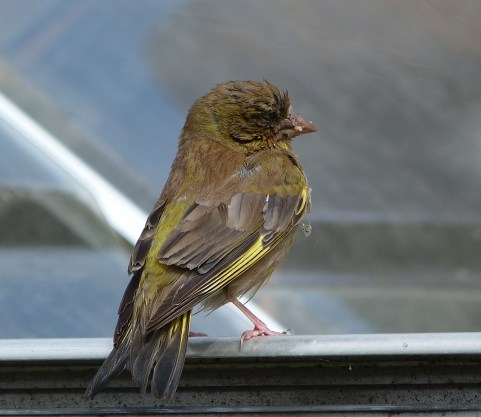
Warblington
This morning
(6:20am to 8:23am) Peter Milinets-Raby took the
opportunity of a fine morning to have an exploration
around the cress beds of Warblington Farm (with the
permission of Henry Young the farmer), which as can be
seen from the photo no longer exist.
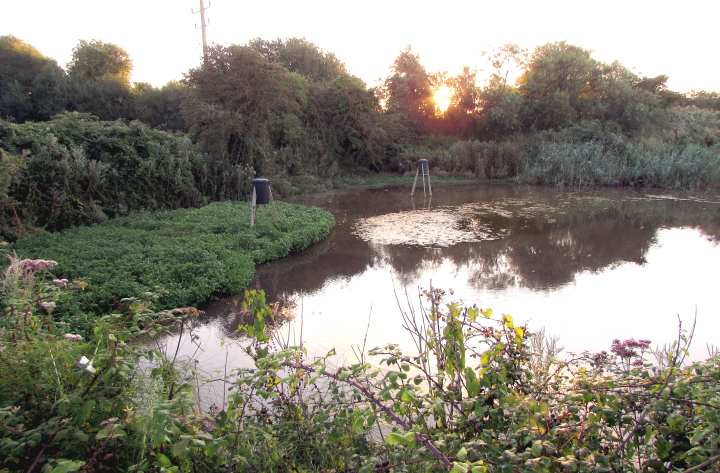
Peter says, "I get the
impression that it was once managed as a wildfowl
'pond', but has been neglected somewhat. The
ramshackle shack/hide is surrounded by months (if not
years) of tangled undergrowth and hasn't been visited
for ages (even I could not get near the place). There
were 2 Teal and 2 Moorhen on the pond and a roosting
Buzzard was disturbed from one of the trees. With all
the recent rain, the water level is obviously high,
but I got the impression that the edges (when
shallower) could/will entice a Green Sandpiper in to
feed. It alas what not what I was expecting. More a
night time roost for duck. "
Peter also sent a
photo a drone that he saw over Langstone Mill Pond
yesterday. He says, "There must be laws to protect
sites from this sort of thing. I was very surprised
how the birds reacted to the drone, as if a bird of
prey was in the area and everything scarpered. And
that poor Oystercatcher frantically calling for
minutes on end and flying around the
drone."
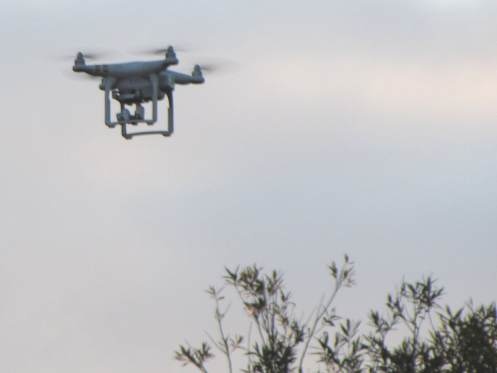
Wryneck
at Warsash
Tony Wootton
got this photo of a Wryneck at Warsash NR today. Nice
one.

TUESDAY
SEPTEMBER 1 - 2015
Banded
Snail
Snails are
fairly common around Brook Meadow, but I rarely bother
to look at them closely. This morning I stopped to
inspect this colourful chap resting on a bindweed
leaf. I think it must be either White-lipped Snail
(Cepaea hortensis) or Brown-lipped Snail
(Cepaea nemoralis) which are the two
most common Banded Snails. The Dark-lipped usually has
a dark brown lip around the entrance to its shell,
while the White-lipped normally has a white lip at its
shell entrance. This one appears to have a white lip
around the entrance, so I will go for Cepaea
hortensis, but without any degree of
confidence. Are there any snail experts out there, I
wonder?
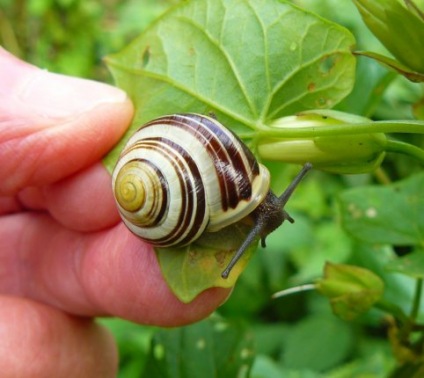
More
spiders
Following on
from the photo of male and female Four-spot Spiders
courting that Malcolm Phillips took last week, today
he got a photo of a female Garden Spider
(Araneus diadematus) finishing off an
unfortunate male which had probably just consummated
the 'marriage', but had got too close to the female.
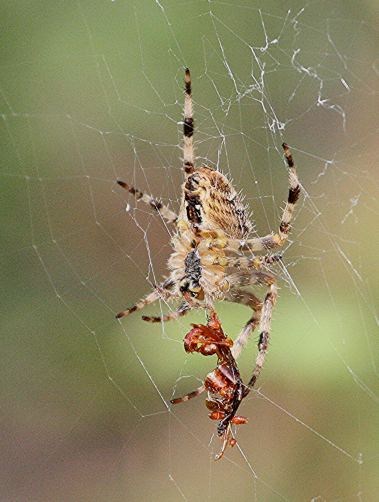
Malcolm also got a
photo of a Wasp Spider (Argiope
bruennichi) on its web showing the vertical
stabilimentum very clearly. Wasp Spiders are fairly
common on Brook Meadow, but this was the first
reported this year. It gets its name from its
wasp-like marking, not from any sting which it does
not have.
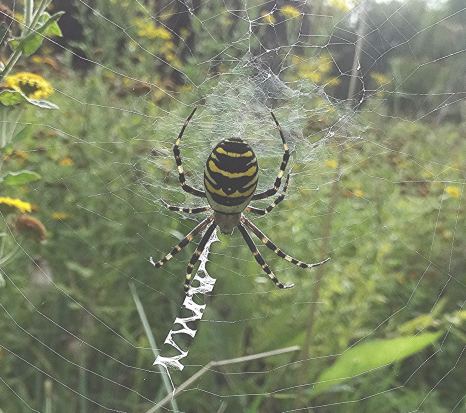
Brown
Argus
Many thanks to
Tom Bickerton for spotting the black marks on the
upper wings on the butterfly photo taken by Malcolm
Phillips on 29 Aug which I thought at first was a
female Common Blue. The marks clearly indicate a Brown
Argus - the first sighting on Brook Meadow since 2011.
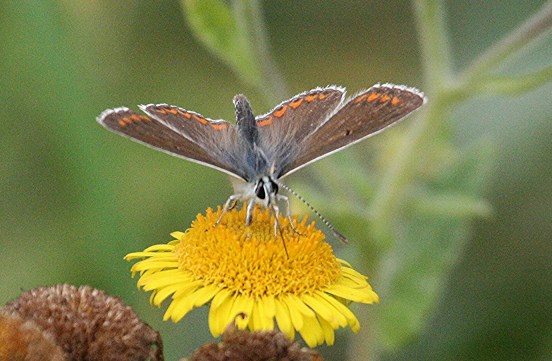
Langstone
Mill Pond
Peter
Milinets-Raby just returned from Langstone Mill Pond
(7:25pm to 8:25pm) where 101 Little Egrets went into
roost .
"On
arrival there was a drone being flown around above the
pond and out across the harbour. Everything scattered
and an Oystercatcher with frantic calls chased after
it for five minutes at least as the drone flew around
back and forth.
Other species of note: Tawny Owl heard calling from
the back of the pond. Little Grebe on the pond with 2
eclipse Gadwall. Kingfisher being pestered by 15+
Magpies coming into roost and chasing the Kingfisher.
200+ Swallow into roost after sunset. "
For
earlier observations go to . . August
17-31